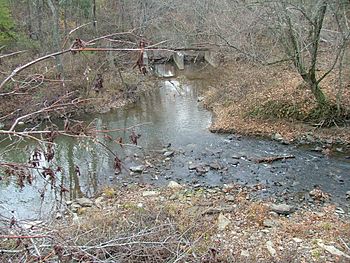Little Emory River facts for kids
Quick facts for kids Little Emory River |
|
|---|---|

Confluence of Little Emory River and Bitter Creek near US 27
|
|
| Physical characteristics | |
| Main source | Morgan County, Tennessee near the town of Coalfield |
| River mouth | Emory River in Roane County 741 ft (226 m) |
The Little Emory River is a river in Tennessee, United States. It starts in Morgan County, Tennessee near a town called Coalfield. This river is an important "tributary" to the larger Emory River. A tributary is like a smaller stream or river that flows into a bigger one.
Contents
Discover the Little Emory River
The Little Emory River flows through beautiful parts of Tennessee. It's known for its connection to a large lake, which makes part of the river behave a bit differently.
Where Does It Begin?
The Little Emory River begins its journey in the hills of Morgan County, Tennessee. This area is close to the small town of Coalfield. From there, the river starts to flow, gathering water as it goes.
Journey to Watts Bar Lake
As the Little Emory River continues its path, it eventually crosses into Roane County. Here, something interesting happens: the river becomes an "embayment" of Watts Bar Lake. An embayment is like a bay or a wide part of a body of water that extends into the land.
What is a Reservoir?
Watts Bar Lake is not a natural lake; it's a "reservoir." A reservoir is a large, artificial lake that is created when a dam is built across a river. In this case, Watts Bar Lake was formed by a dam on the Tennessee River. Reservoirs are often used to store water for drinking, to generate electricity, or to control floods.
Slowing Down: Slack Water
Because Watts Bar Lake is a very deep reservoir, its waters can reach far up into the rivers that flow into it. This creates what is called "slack water" conditions. "Slack water" means the river's current becomes very slow, almost like still water, for many miles upstream from where it meets the main lake. This happens not just in the Little Emory River, but in other rivers that feed into the Tennessee River system too.

